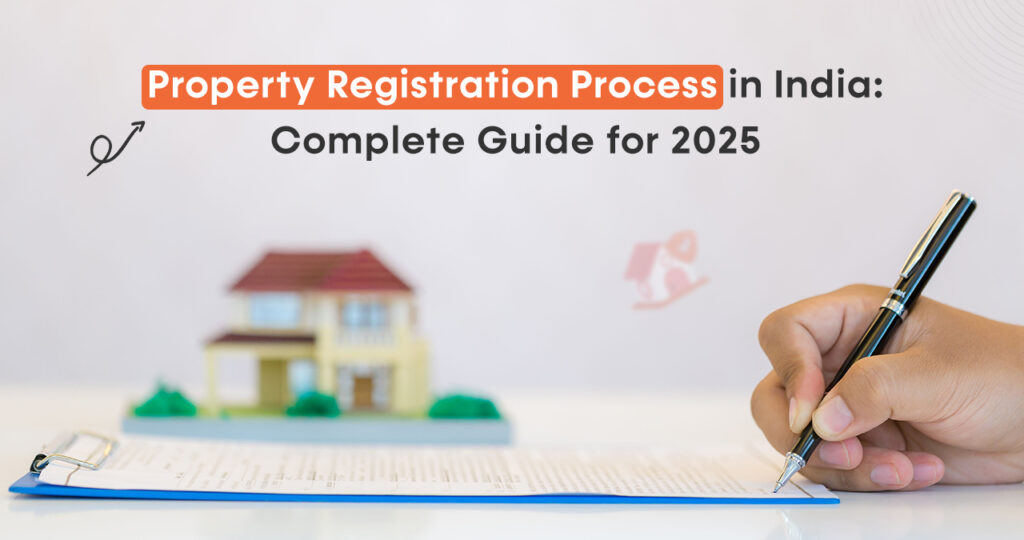The process of buying or selling property in India is incomplete without proper registration. Property registration is a legal formality that transfers ownership from the seller to the buyer, ensuring the transaction is recognized by law. Governed by the Registration Act, 1908, this process is mandatory for most real estate transactions in India and provides security against disputes while establishing clear ownership rights. With the Indian real estate market evolving rapidly, understanding the property registration process is crucial for buyers, sellers, and investors alike.
As we step into 2025, staying updated with the latest guidelines, procedures, and potential changes is more important than ever. This comprehensive guide will walk you through every step of the property registration process in India, tailored specifically for the Indian real estate market. Whether you’re a first-time buyer or a seasoned investor, this article will equip you with the knowledge to navigate the process seamlessly.
Introduction to Property Registration in India
In India, registering a property is not just a procedural step—it’s a legal necessity that safeguards your investment. The property registration process involves submitting essential documents, paying applicable fees, and recording the transaction with the sub-registrar’s office. This ensures that the property’s ownership is officially transferred and documented in government records.
The importance of property registration cannot be overstated. It protects buyers from fraudulent transactions, establishes legal ownership, and serves as evidence in case of disputes. With real estate being a significant investment in India, adhering to the latest regulations in 2025 will ensure your transaction is smooth and compliant.
This guide covers everything you need to know about the property registration process in India for 2025, including preparation, required documents, stamp duty calculations, and post-registration formalities. Let’s dive into the details.
Preparation Before Registration
Before you register a property, thorough preparation is key to avoiding delays or complications. Here are the essential steps to take:
1. Title Verification
Ensure the seller has a clear and marketable title to the property. This involves checking the property’s ownership history, past sale deeds, and any legal claims. A clean title is the foundation of a secure transaction.
2. Encumbrance Certificate
Obtain an encumbrance certificate from the sub-registrar’s office. This document confirms that the property is free from mortgages, loans, or other legal liabilities. It typically covers the last 12-30 years, depending on state requirements.
3. Approvals and NOCs
For properties in housing societies, under development authorities, or requiring specific clearances (e.g., agricultural land), secure all necessary No Objection Certificates (NOCs). These might include NOCs from the society, bank (if the property was mortgaged), or local authorities.
4. Property Valuation
Get the property valued by a certified valuer to determine its fair market value. This valuation is critical for calculating stamp duty and ensuring you’re not overpaying.
5. Drafting the Sale Deed
The sale deed is the primary document transferring ownership. Draft it with the help of a legal expert, including all terms of the sale (price, conditions, etc.), and ensure both parties review it carefully.
By completing these steps, you’ll lay a strong groundwork for a hassle-free registration process.
Documents Required for Property Registration
The property registration process in India requires a set of documents to be submitted to the sub-registrar. Missing or incorrect documents can derail the process, so ensure you have the following ready:
- Sale Deed: The original agreement transferring ownership.
- Title Documents: Proof of the seller’s ownership (e.g., previous sale deeds, partition deeds).
- Identity Proofs: Government-issued IDs for buyer and seller (Aadhaar card, passport, driver’s license).
- Address Proofs: Utility bills, ration card, or similar documents for both parties.
- Property Tax Receipts: Evidence of up-to-date tax payments.
- Encumbrance Certificate: To verify the property is free of liabilities.
- NOCs: From relevant authorities, if applicable.
- Power of Attorney: If someone is acting on behalf of the buyer or seller.
- Photographs: Passport-sized photos of the buyer and seller.
- Witness Documents: Identity proofs of two witnesses present during registration.
Ensure all documents are original, signed, and match the details in the sale deed. Double-check with your state’s sub-registrar office for any additional requirements specific to 2025.
Stamp Duty and Registration Fees
Understanding Stamp Duty
Stamp duty is a state-imposed tax on property transactions, calculated as a percentage of the property’s market value or the agreed consideration amount (whichever is higher). Rates vary across states, typically ranging from 4% to 10%. For example:
- Maharashtra: ~5-6%
- Tamil Nadu: ~7%
- Delhi: ~4-6% (lower for women buyers)
In 2025, some states may offer concessions for women buyers, first-time homeowners, or senior citizens. Check your state’s latest policies for updates.
Calculating Stamp Duty
![]()
For instance, if a property in Karnataka (stamp duty rate: 5%) is valued at ₹60,00,000:
Stamp Duty=60,00,000×0.05=₹3,00,000
Registration Fees
In addition to stamp duty, a registration fee (usually 1% of the property value) is payable. For the same ₹60,00,000 property:
Registration Fee=60,00,000×0.01=₹60,000
Payment Methods
Pay stamp duty via:
- E-stamping: Online payment portals.
- Franking: At authorized banks.
- Stamp Papers: Physical purchase (less common in 2025 due to digitization).
Pay before the registration date to avoid last-minute hiccups.
Property Registration Process
Here’s a step-by-step breakdown of the property registration process in India:
1. Book an Appointment
Schedule a visit to the sub-registrar’s office in the property’s jurisdiction. Many states, like Maharashtra and Tamil Nadu, offer online booking in 2025 for convenience.
2. Submit Documents
On the appointed day, the buyer, seller, and two witnesses must visit the office with all required documents (sale deed, IDs, stamp duty receipts, etc.).
3. Verification
The sub-registrar verifies the documents for accuracy. Biometric verification (fingerprints) or thumb impressions may be required to prevent fraud.
4. Pay Registration Fees
Pay the registration fee (typically 1% of the property value) at the office counter or online, depending on the state.
5. Sign the Deed
Both parties and witnesses sign the sale deed in the sub-registrar’s presence, formalizing the transaction.
6. Property Registration
The sub-registrar records the transaction, assigns a registration number, and issues a receipt. The registered sale deed is usually available within a few days.
The process duration varies—some offices complete it in hours, while others may take days. Arrive prepared to minimize delays.
Post-Registration Steps
Registration isn’t the end of the journey. Complete these steps to finalize the transfer:
1. Collect the Registered Deed
Pick up the original registered sale deed from the sub-registrar’s office (usually within 7-15 days).
2. Update Records (Mutation)
Apply for mutation at the local municipal office to update ownership details in revenue records. Submit the registered deed, tax receipts, and ID proofs.
3. Pay Property Taxes
Ensure taxes are paid under your name from the registration date to avoid penalties.
4. Notify Authorities
Inform the housing society, electricity board, water department, or other relevant bodies about the ownership change.
5. Secure the Property
Take possession and install security measures (locks, alarms) to protect your investment.
These steps ensure your ownership is fully recognized legally and administratively.
Common Challenges and How to Overcome Them
The property registration process can hit roadblocks. Here’s how to tackle common issues:
1. Document Discrepancies
Errors in names, dates, or property details can stall registration. Solution: Verify all documents beforehand and correct discrepancies with legal assistance.
2. Stamp Duty Disputes
Disagreements over property valuation or rates may arise. Solution: Obtain a certified valuation and consult a lawyer or chartered accountant.
3. Legal Heir Conflicts
If the property has multiple heirs, securing their consent can be tricky. Solution: Start early, gather NOCs, and involve a mediator if needed.
4. Delays at the Sub-Registrar’s Office
Bureaucratic inefficiencies are common. Solution: Book appointments online, follow up regularly, and consider hiring a local agent.
5. Fraud Risks
Fake titles or sellers can jeopardize your investment. Solution: Conduct thorough title checks and hire a real estate lawyer.
Proactive planning can turn challenges into manageable hurdles.
Conclusion
The property registration process in India is a vital cog in the real estate wheel, ensuring your investment is secure and legally sound. From verifying titles and paying stamp duty to completing registration and updating records, each step plays a critical role. As we move into 2025, staying informed about state-specific updates, digital advancements (like e-registration), and potential concessions will give you an edge. Also, check the Circle rates of that area where you are planning to buy a property.
By following this guide, you’ll be well-equipped to handle the property registration process with confidence. Seek professional advice when needed, double-check your documents, and approach the process methodically. A registered property isn’t just an asset—it’s peace of mind. Now, Lets Rentz is also in property buy and sell services in Chandigarh, Try City, and Delhi NCR. If you want to buy or invest in a property washout brokerage, you can visit Lets Rentz.
Frequently Asked Questions (FAQs)
What’s the deadline for registering a property after purchase?
You must register within four months from the sale deed’s execution date, per the Registration Act, 1908. Delays may incur penalties.
Can I register a property online in 2025?
Yes, some states (e.g., Maharashtra, Delhi) offer online registration facilities. Check your state’s portal or sub-registrar’s office.
What if I skip property registration?
Unregistered properties lack legal validity, risking ownership disputes or loss of rights.
How do I track my registration status?
Use your state’s online registration portal with your registration number or visit the sub-registrar’s office.
Are there stamp duty exemptions?
Certain states provide concessions for women, senior citizens, or affordable housing buyers. Verify with local authorities.



